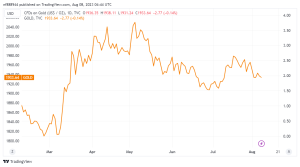The price of gold declines for the second day in a row as the US dollar regains its footing following Friday’s sell-off.
The gold price is continuing to fall, approaching a three-week low of $1,926 early Tuesday. A new risk-aversion wave appears to be working as a tailwind. Restoring safe-haven demand for the US Dollar (USD). As traders await Chinese and US inflation data for a new directional impulse in the gold price.
Risk sentiment will be crucial ahead of significant inflation numbers.
Following the data-driven sell-off in the United States job market. The US Dollar, or Greenback, recovered positive traction against its main counterparts at the start of the week. Profiting on market jitters ahead of crucial inflation data releases from both China and the United States.
Along with the US Treasury bond yields. The US Dollar was buoyed by hawkish remarks by US Federal Reserve (Fed) Governor Michelle Bowman. Bowman stated at an event in Atlanta on Monday. “I will be looking for evidence that inflation is on a consistent and meaningful downward path. As I consider whether further increases in the federal funds rate will be needed. And how long the federal funds rate will need to remain at a sufficiently restrictive level.”
According to CME Group’s FedWatch Tool, approximately 86.5% of Market participants anticipate. That the central bank will not raise interest rates in September. Investors remain optimistic about a final Fed rate hike this year. With Thursday’s Consumer Price Index (CPI) data from the United States expected to confirm any future Fed rate hike projections. Resurgent US Dollar demand sent gold prices back to multi-month lows.
Investors remain wary as major inflation figures from China and the United States are released.
So far in Tuesday’s trade, investors have fled to the US Dollar for safety. Amid rising geopolitical dangers between China and Japan over Taiwan. Aso of Japan’s Liberal Democratic Party stated, “In Taipai. We are moving from peacetime to times of turbulence.” “Japan has continued to say that peace and the Taiwan Strait are important for regional stability,” Also stated.
Meanwhile, there are concerns about China’s economic performance. The country’s recovery accelerated as exports fell 14.5% year on year in July, while imports declined 12.4%, according to the most recent China Customs statistics released on Tuesday. Following the Chinese trade numbers, the US dollar remained strong, keeping the gold price under pressure. The downside in the gold price appears to be limited, owing to a lackluster performance in US Treasury bond yields across the curve.
Moreover Traders are now looking forward to Wednesday’s Chinese CPI and Producer Price Index (PPI) statistics, as they look for more signs of deflation in the world’s second-largest economy. In the absence of top-tier US economic data releases on Tuesday, traders will also take signals from Wall Street emotion and Fedspeak.
Technical analysis
The gold price has been volatile. Rejection at the flattish 50-day moving average (DMA) of $1,945, strengthening selling pressure toward the three-week lows of $1,926.
Immediate support can be found at $1,930. A significant break below the multi-week low of $1,926 is required to continue the decline toward the $1,910 demand region.

The 14-day Relative Strength Index (RSI) indicator falls below the midline, indicating that the path of least resistance for Gold appears to be to the downside.
Acceptance over the 50 DMA at $1,945, on the other hand, is key to igniting further rebound toward the bullish 21 DMA at $1,954. The triangle support-turned-resistance at $1,961 is seen as the next potential upward Hurdle.









